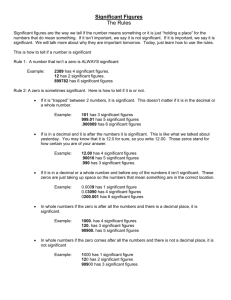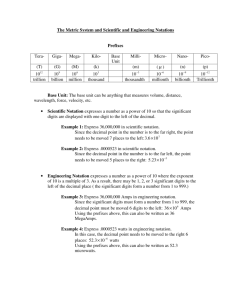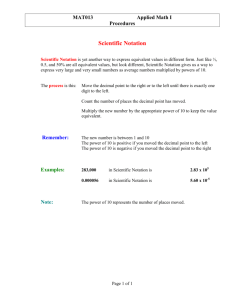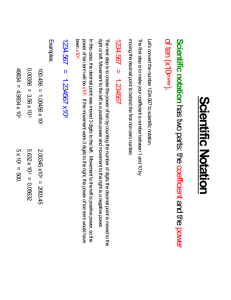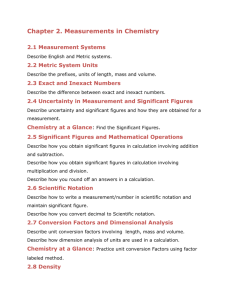Physics Regents Review
advertisement
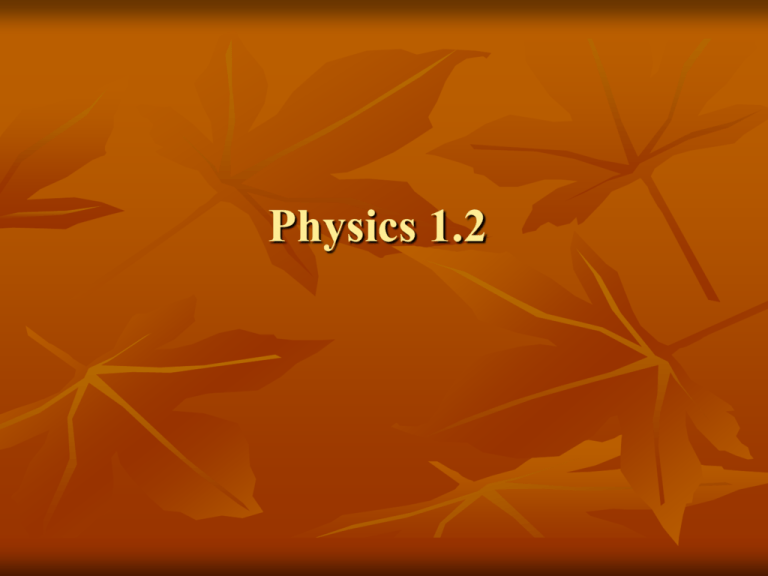
Physics 1.2 Measurements and Mathematics Unit: Standard unit of: time, distance, mass, etc. SI system Scientific measurements SI prefixes and symbols Some Units of Measure: Dimensional Analysis: A way to examine the accuracy of a particular formula. Also allows one to convert and cancel units. Example: Si Prefixes: Tools for Measurement Length Mass Stop watch Force Electronic balance Time Metric ruler Spring scale Angle Protractor trigonometry Trigonometry SOH CAH TOA Sample Problem A block is displaced a vertical distance of 0.75 meters as is slides down a 1.25-meter long plane inclined to the horizontal. a) b) How far is the block displaced horizontally? What is the measure of the angle of inclination of the plane to the horizontal? Uncertainty in measurement Precision: Multiple measurements are nearly identical. Accuracy: Measurements are very close to accepted value found in reference table. Significant Figures 0.040900 has how many sig figs? Zeros before nonzero digits are not significant. Zeros between nonzero digits are significant. Zeros after nonzero digits are only significant if they: a. b. Are followed by a decimal point. Are to the right of a decimal point. Addition, Subtraction, Multiplication, and Division: RULE: When adding or subtracting your answer can only show as many decimal places as the measurement having the fewest number of decimal places. RULE: When multiplying or dividing, your answer may only show as many significant digits as the multiplied or divided measurement showing the least number of significant digits. Sig Fig Problems: Example: When we add 3.76 g + 14.83 g + 2.1 g = 20.69 g. We must round our answer, 20.69, to one decimal place (the tenth place). Our final answer is 20.7 g. Example: When multiplying 22.37 cm x 3.10 cm x 85.75 cm = 5946.50525 cm3. Our final answer becomes 5950 cm3. Scientific Notation Used to express very large or very small measurements. Ex/ The number 123,000,000,000 in scientific notation is written as : Rules for Scientific Notation: Rule for Addition and Subtraction - when adding or subtracting in scientific notation, you must express the numbers as the same power of 10. This will often involve changing the decimal place of the coefficient. Rule for Multiplication - When you multiply numbers with scientific notation, multiply the coefficients together and add the exponents. The base will remain 10. Rule for Division - When dividing with scientific notation, divide the coefficients and subtract the exponents. The base will remain 10. Orders of Magnitude: Estimating the answer allows you to check if your calculated answer is reasonable. Sometimes, you can steal an answer quickly and save time. On the Regents exam, this is rare, so be careful! Sample Problem: Estimate the magnitude of the gravitational force between earth and the moon and compare it with the actual value. gravitational constant G = 6.67300 × 10-11 m3 kg-1 s-2 mass of Earth = 5.9742 × 1024 kilograms mass of the Moon = 7.36 × 1022 kilograms Distance (r)= 3.84E8 meters Another Problem: As the Voyager spacecraft passed the planet Uranus, it sent signals back to Earth. Determine the order of magnitude of the time in seconds for a signal to reach Earth. The distance from Earth to Uranus is 2.71E12 m. The speed of light in a vacuum is 3.00E8 m/s. From V=d/t Evaluating Experimental Results: Data Analysis Range: highest to lowest. Mean: average Variance: sum of the squares of differences of values from mean. Standard Deviation: square root of the variance Problem: In an experiment, a student determines that the acceleration due to gravity in the laboratory is 9.98 m/s². Determine the percent error. (The accepted value for the acceleration due to gravity is 9.81 m/s².) Percent Error: % error = | your result - accepted value | x 100 % accepted value Graphing Data: Independent variable Dependent variable One that experimenter changes, x or horizontal axis. One measured for change due to change in independent variable, y or vertical axis. Line of best fit A straight or curved line which approximates the relationship among a set of data points. May be extrapolated (extend beyond data). A common statistical function to execute is something called a linear regression. Linear regression looks for a correlation between an independent variable and a dependent variable. Let’s say our independent variable is time, and our dependent variable is a batter’s home run totals. The following is a time series plot of home run numbers for Cal Ripken: More graph stuff: The slope of a graphed line is defined as a ratio of ∆y/ ∆x. Sample Problem: The position of a moving car was measured at one second intervals and recorded in the following table. Graph the data on graph paper and draw the line of best fit. Determine the slope of the line. Time (s) 0.0 Position (m) 0 1.0 18 2.0 40 3.0 62 4.0 80 5.0 100 Types of proportions: Direct proportion Inverse proportion Increase in one causes a squared increase in another. Indirect squared proportion Increase in one causes decrease in another Direct squared proportion Increase in one causes increase in another. Increase in one causes a squared decrease in another. Constant proportion Increase in one causes no change in another. More Graphs:

